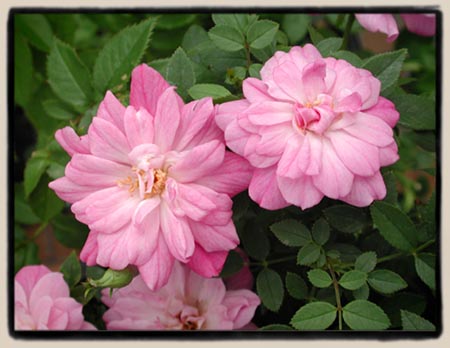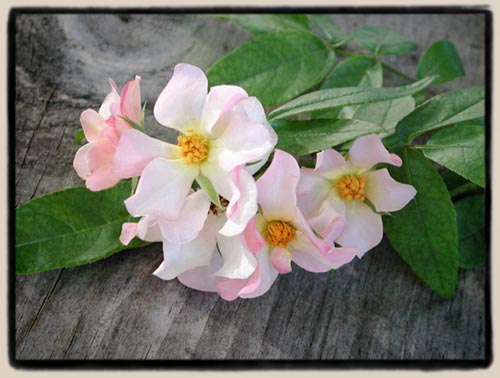 |
|
Albas |
Welcome to the April 2003 edition of my web site! The roses I write about are the Old Garden Roses and select shrub and miniature roses of the 20th century. For tips on rose culture, pruning, propagation and history, see the "Site Resources Guide" box in the navigation panel at left. To return to this page, click on the "thorn icon" in the margin at left. Articles from the previous months are archived and can be viewed by clicking on the listings in the left margin. Oh, and please don't write to me for a catalog or pricelist.....this is an information site only, not a commercial nursery. If you wish to buy roses, see my sponsor, The Uncommon Rose. What Was Lost is Found…. Prequel
and Setting by Jim Delahanty
Denouement by Kim Rupert Prequel: In the early 1950’s three yellow roses were introduced into the American rose scene:
Left: 'R. rouletii' ‘Yellow Sweetheart,’ a floribunda with lemon yellow petals with a sulfur reverse, was a Gene Boerner introduction from Jackson and Perkins. It was the result of a cross between ‘Pinocchio’ X an unnamed seedling. ‘Climbing Yellow Sweetheart’ was a 12 foot floribunda by Ralph Moore with a color range from apricot to creamy yellow and a product of ‘Etoile Luisante’ seedling X ‘Goldilocks.’ The only characteristic necessarily shared by these introductions (aside from being in the yellow color range) was a commonality of the term ‘yellow sweetheart.’ Neither of the floribundas is currently in commerce nor apparently available in either public or private gardens. The Setting and Protagonist: Carole Aguilar has lived in the same house in Glendale, in an area not far from Griffith Park and San Fernando Blvd., for over four decades. Many of the roses in her yard antedate her arrival. Some of the older roses, such as ‘Nocturne’ and ‘Roundelay,’ are tagged; others, such as ‘Mlle. Cecile Brunner,’ are easily identifiable. Of the other older roses she tends to give them what she considers appropriate names: ‘Butterscotch,’ or ‘Moonlight,’ or some other identifying attribute of color or possession. She has been a volunteer at Descanso Gardens, and a working assistant to Wilbur Wood, a prominent California plantsman and force in the California Rare Fruit Growers Association. She has always considered herself a horticulturist—one who collects plants and digs up lawn to find places to put them; more recently, she deems herself a gardener—one who arranges for vistas and paths. Actually, she is an ‘enabler,’ someone who encourages others to take cuttings of her roses and other plants as a hedge against the inevitable encroachment of city plans for multi-density dwellings. The genesis of her horticultural interests originated in reading a copy of the original Luther Burbank manuscript on grafting available in her local high school. We became acquainted through the agency of Bill and Janie Hillman, mutual friends, at first through meetings at a gathering of people involved in Internet chatting and later as members of a group of persons interested in variety of topics united and divided by age and attitudes. As a consequence of my mentioning an interest in preserving roses that might otherwise be lost by virtue of leaving (or in some cases, never entering) commerce, she offered to provide cuttings of ‘Nocturne,’ ‘Roundelay,’ and the older roses dubbed by characteristics. Successful cuttings were taken of these roses and dispersed among persons interested in them or through the agencies of rose auctions and local society raffles (Ventura County Rose Society) as well as exchanges and plant swaps among those interested in heritage roses (Gold Coast Heritage Rose Society).
At one point Carol mentioned in an e-mail, that she was willing to give cuttings of ‘Cecile Brunner’. (Actually, ‘willing’ is inaccurate; eager to the point of excess is closer to the reality.) My reaction was to note that I had four of them, that I had already taken cuttings successfully, and that this was in no way an endangered plant. She then mentioned a climbing version of ‘Yellow Cecile Brunner.’ My interest perked up because ‘Perle D’Or,’(1) was commonly called ‘Yellow Cecile Brunner’ and because a climbing version of ‘Perle D’Or’ was no longer in commerce. In any case, a visit produced more cuttings, and several blooms. The plant was approximately twelve feet tall, floriferous to a great degree, despite receiving no care aside from a little water runoff from a nearby sprinkler aimed at the lawn. No fertilizer. No spray. Incidental water. This was one tough plant. The foliage was leathery rather than soft and the late Spring buds have an orange cast to them rather than the golden pink of 'Perle D'Or.' Nevertheless, some cuttings were sent to Paul Zimmerman of Ashdown Roses, who reported back that they were among the fastest responding cuttings imaginable. My experience was the same, since fifteen cuttings produced nearly a dozen ‘takes’ early on. At that point, my friend Kim suggested several possibilities that the rose might be: ‘Little Jackie,’ ‘Climbing Goldilocks,’ or ‘Climbing Yellow Sweetheart.’ But his original assessment was that it was probably Sweetheart. JD The Denouement: Jim had posted that he’d found ‘Climbing Perle D’Or (2), which would have been a wonderful discovery. We decided through e-mails that we should get together and take a look at the plant, which we did. The neat lady who has been growing this rose for nearly half a century is quite a person! She’s a real horticulturalist. You know, the kind who grows about everything because she just loves the plants. And, she knows what they are and how to take care of them. The plant she showed us grows up the side of her garage, where it’s been growing for about fifty years. It’s totally thornless and has clusters of buttery yellow buds, opening to light yellow, semi- double, fragrant blooms. This was not Perle d’Or, but it impressed me as being something I should recognize. There was just something about it which seems very familiar. As I studied the plant for clues, the thought that it must be a Ralph Moore rose nagged at me. Jim took cuttings of our yellow rose and sent some to Ashdown for Paul Zimmerman to try rooting. They rooted quite well for Jim, and Paul reports he got nearly a hundred per cent take under mist. This is an important clue. Ralph Moore would never introduce a rose which doesn’t root easily. This is one of his first requirements for a ‘good rose.’ The plant was well established when Carol bought her house in the early sixties. This rose is thornless, and roots very easily. There is quite a bit about it which reminds me of Opal Brunner (3), an Edward Marsh introduction. Edward Marsh introduced a few roses for Ralph Moore in the l940’s and l950’s, and his nursery was near where this rose has grown over the decades. Plus, there is a very old, well-established plant of another Marsh rose, Lady Ann Kidwell (4), in the garden. This unidentified or ‘found’ rose had to be Climbing Yellow Sweetheart. Mr. Moore bred Climbing Yellow Sweetheart from an Etoile Luisante (5) seedling with pollen from Goldilocks (6). It was introduced by Marsh’s Nursery in l952. It’s described as "flowers apricot-yellow to creamy yellow, small, double (26 petals), exhibition form, moderate fragrance; foliage leathery, glossy, vigorous, climbing growth (to 12 feet)." While I hadn’t seen the apricot tones, the buds are buttery/creamy yellow. They do open creamy light yellow and look to be of about 26 petals. The plant easily goes over the edge of the single car garage roof, so the height is right. Yesterday (September 10th) Jim and I ventured into the smoke from the Glendale fire, which is straight up the mountain from Carol’s garden. While being fed over ripe Black mission figs and incredible vine ripened Golden Muscat grapes, we took cuttings and clusters of buds and flowers to send to Sequoia Nursery. As we wanted to be sure they were fresh enough to identify, we took them straight to the Post Office, where I sent them Express Mail. Of course, I didn’t remember to email Carolyn (Supinger) to expect them. They arrived next day and inspired an email asking what they were. I immediately called Carolyn and told her what we suspected the rose to be and why. She said that was interesting as she thought it resembled Etoile Luisante as she opened the package. She seemed as excited as we were at the possibility of unearthing an "extinct" Ralph Moore rose. She said she’d take them right in to show Mr. Moore. Tonight’s email reports that Mr. Moore is "pretty sure" its ‘Climbing Yellow Sweetheart.’ That’s good enough for me. Even though he has released nearly four hundred roses in the past seventy-three years, he would know one of his own. Carolyn said she’s only seen a drawing of the rose, and she’s worked at Sequoia for over 25 years, plus spent much of her childhood there as her mother worked there before her. They used to have a lady who drew the roses for the catalogs, and there was the drawing of it for the patent application. She’s going to look them up when she has time.
I think it is the resemblance to Etoile Luisante offspring which triggered my thought it had to be a Moore rose. Etoile Luisante was used to create Renae (7), Carolyn Dean (8), Everbloom1 (9), Dancing Doll (10)…as well as my own Annie Laurie McDowell (11). These all have a ‘feel’ to them which appears to have come from their shared polyantha parent. Jim and I are thrilled! We’ve been able to discover a treasure, which remained ‘buried’ for fifty years, and nearly in our own back yards. And we have the joy of returning it to its Creator, Ralph Moore. KR 1 ‘Perle D’Or’, polyantha, yb, Rambaux, 1884 2 ‘Cl Perle D’Or, Cl polyantha, yb. (MRXI gives no introducer or date) 3 ‘Opal Brunner,’ Cl Floribunda, O.C. Marsh "about 1948." 4 ‘Lady Ann Kidwell,’ polyantha, dp, Krebs, 1948 5 ‘Etoile Luisante,’ polyantha, mr Turbat, 1918 6 ‘Goldilocks,’ Floribunda, my, Boerner, l945 7 ‘Renae,’ Cl Floribunda, mp, Moore, 1954 8 ‘Carolyn Dean,’ LCL, mp, Moore 1941 9 ‘Everbloom1’ (unreleased Moore rose, c. 1950’s) 10 ‘Dancing Doll,’ Cl Floribunda, dp, Moore, 1952 11 ‘Annie Laurie McDowell,’ LCL, mp, Rupert, 2001
Original photographs and site content © Paul Barden 1996-2003 |
|


 Right:
'Climbing Yellow Sweetheart', photo taken circa 1954
Right:
'Climbing Yellow Sweetheart', photo taken circa 1954
